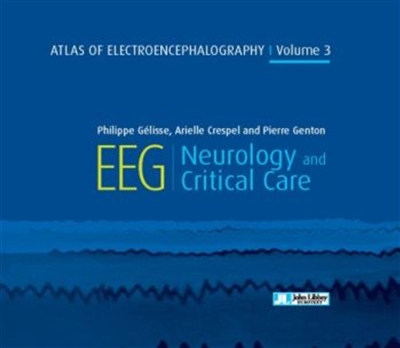en savoir plus

Permet à tous ses détenteurs d'obtenir 5% de réduction sur tous les livres lors du retrait en magasin (réduction non cumulable avec les réductions de type étudiant).
Offre également un certain nombre d'avantages auprès de nos partenaires.
Avec les favoris, retrouvez dans un espace les sélections effectuées au fur et à mesure de vos navigations dans le site.
Constituez pour votre usage personnel vos listes de livres en prévisions d'achats futurs et votre sélection d'articles, dossiers, événements, vidéos ou podcasts préférés ou à découvrir plus tard...
Il suffit simplement de cliquer sur "Ajout Favori" sur chaque page qui vous intéresse pour les retrouver ensuite dans votre espace personnel.
Requiert un compte Mollat
Requiert un compte Mollat
Atlas of electroencephalography. Vol. 3. Neurology and critical care
Auteur : Philippe Gélisse
Auteur : Arielle Crespel
Auteur : Pierre Genton
en savoir plus
Résumé
Près de 160 planches commentées et analysées afin de démontrer l'utilité du recours à l'électroencéphalographie en pratique neurologique générale. Cet outil permet notamment d'évaluer l'état de vigilance, le risque d'activité convulsive ou encore le type et le degré de déficience fonctionnelle, aidant ainsi au diagnostic et au traitement. ©Electre 2025
Quatrième de couverture
Atlas of electroencephalography | Volume 3
EEG
Neurology and Critical Care
The third volume of the series of Atlases deals with the use and usefulness of electroencephalography (EEG) in neurology.
While EEG is universally recognized as a first-order investigation method in epilepsy (see volume 2), and as an important contributor in sleep medicine, practical neurology has tended to neglect the value of this classical and established neurophysiological tool. A rich, extensively commented and analyzed collection of EEG plates is presented here.
The reader will be compelled to remember that EEG is the easiest way to assess parameters like state of vigilance, risk of seizure activity, type and degree of functional impairment, in a very clinical and practical setting. The authors cover many aspects of neurological practices where the EEG may help in diagnosis and treatment : metabolic and other encephalopathies, infectious and inflammatory conditions, vascular disorders. It is particularly useful - and difficult - to distinguish between epileptic phenomena and EEG changes associated with metabolic abnormalities : a careful assessment of the EEG is of paramount practical importance here. Migraine is not always simple and there are many overlaps with other types of neurological diseases : the EEG may play a major part in helping the clinician in doubtful cases. Similarly, the diagnosis of dementia does certainly not rest on the EEG but many particular aspects concerning diagnostic overlaps or copathologies are aptly explored by the EEG. Lastly, even the neurosurgeon may need the EEG to monitor trauma, tumor, bleeding...
This Atlas will provide both examples and guidelines for the optimal use of the EEG in neurology.
Fiche Technique
Paru le : 04/07/2019
Thématique : Neurologie - Psychiatrie
Auteur(s) : Auteur : Philippe Gélisse Auteur : Arielle Crespel Auteur : Pierre Genton
Éditeur(s) :
John Libbey Eurotext
Collection(s) : Non précisé.
Contributeur(s) : Préfacier : Andrea O. Rossetti
Série(s) : Atlas of electroencephalography
ISBN : 978-2-7420-1579-5
EAN13 : 9782742015795
Reliure : Relié
Pages : 346
Hauteur: 25.0 cm / Largeur 31.0 cm
Épaisseur: 2.2 cm
Poids: 1556 g

